Four Qigong Exercises
|
By: Dr Paul Lam
© Copyrights Tai Chi Productions 2007. All rights reserved, no part of this article may be reproduced in any forms or by any means, without permission in writing, except for non-profit educational purpose. For example: you can photocopy this article for a friend, paying student, or conference participant as long as this article is not included as part of your charge
|
|
Qigong is one of the oldest exercises in Chinese history, dating back more than one thousand years. There are numerous types of Qigong. Generally speaking, Qigong is a variety of breathing, gymnastic, and meditative exercises. In Chinese, Qi means several things; the most common meaning of Qi is air. Here, Qi means the life energy inside a person. This life energy comes from the combination of three things: the air breathed in through the lungs, essential Qi from the kidney, and the Qi absorbed from food and water through the digestive system. Qi circulates throughout the body, performing many functions to maintain good health. The stronger Qi you have, the healthier and stronger you are. The word Gong means a method of exercise that requires a great deal of time in which to become proficient. Simply put, Qigong is a breathing exercise that requires regular practise, and is especially beneficial for health and mental relaxation. Qigong is an integrated part of Tai Chi.
According to ancient Chinese philosophy, the universe started from a vast void, the infinity. It is called wu-ji in Chinese. The main focus of this qigong exercise is for posture awareness. Q1 Stand upright but relaxed, feet apart, knees relaxed, eyes looking forward, chin tucked in, shoulders relaxed. Cleanse your mind and focus on the correct posture-upright without being tense.
2. The Posture of Tai Chi – for Dan Tian awareness
Dan Tian is the area approximately three fingerbreadths from the naval. It is the centre of Qi and the commander of body movements in tai chi practice. From Q1Posture awareness Q2A: Slowly bring your hands up, palms facing each other, breathing in. Q2B: Bring hands towards chest, bending knees slightly.
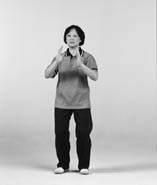 Focus on the Dan Tian. When you get slightly tired, stretch your hands out to the previous posture, bring your hands down and slowly stand up. Dan Tian is an area three finger breadth below the belly button (Umbilicus)
3. The Posture of Opening and Closing – for breathing awareness
Q3A: From the previous posture, breathe in, open hands to shoulder width. If your knees feel tired, gently straighten them. Q3B: Breathe out, pushing hands towards each other as close as possible without touching. Gently bend your knees if you have straightened them in the previous move. Continue opening and closing hands three times, or multiple of. Complete the exercise by stretching your hands forward, return to the previous position and straighten your knees. Do this exercise three or less times to start with and then more as you are get stronger.
Keep your mouth closed but not tight, tongue lightly touching the upper palate Using Dr Lam’s Dan Tian Breathing Method: This breathing method is a modification of traditional qigong based on modern medical research into the deep stabilizer muscles. It helps to sink your qi to the dan tian and to enhance qi power, in turn improving internal energy. It can be incorporated into all your qigong and tai chi movements. You can practise the breathing either sitting or standing upright. Be aware of holding the correct posture. Put left hand on your abdomen just above the belly button and right hand below it. Concentrate on your lower abdomen and the pelvic floor muscle. When you inhale, expand your lower abdominal area—allow it to bulge out a little—and let your abdominal and pelvic floor muscles relax. You should feel a slight pushing out of the right hand. As you exhale, gently contract the pelvic floor muscles and the lower abdomen. Feel the contraction of the muscle with your right hand, keeping the area above your belly button as still as possible. Contract the pelvic floor muscles very gently, so gently that it’s almost like you’re just thinking about contracting them. Another good way is to imagine that you’re bringing your pelvic floor just half an inch closer to your belly button. A stronger contraction would move the left hand too much and that would mean involving different groups of muscles therefore not be as effective. As you inhale and relax the pelvic and lower abdominal muscles, try not to relax them completely but retain approximately 10–20 percent of the contraction. This will allow you to maintain a upright posture and have the right group of muscles ready for the next phase. If you can feel the qi, you can circulate it down along the conception vessel on expiration, and up along the governing vessel on inspiration. Another good way is to visualise your qi move in a straight line just beneath your skin: up to middle of your sternum (the point below two nipples) on inspiration and down to the dan tian on expiration. 4. The Posture of Raising and Lowering – for Qi awareness
Q4A: Bring your hands down and breathe out
Q4B:Bring your hands up along your chest and breath in. Continue moving in the loop, standing up as you breathe in and bending down as you breathe out. Finish off after doing the exercise three times.  When you breathe in, visualize your Qi moving up to the middle of your chest. When you breathe out visualize your Qi moving down to the Dan Tian. It doesn’t matter if you don’t understand what Qi is. Simply think about this area as you breathe in and out. As your Tai Chi improves, you will be able to understand and feel the Qi. While the sensation of Qi is different to different people, for most, it feels like a warm and slightly heavy sensation. When you breathe in, visualize your Qi moving up to the middle of your chest. When you breathe out visualize your Qi moving down to the Dan Tian. It doesn’t matter if you don’t understand what Qi is. Simply think about this area as you breathe in and out. As your Tai Chi improves, you will be able to understand and feel the Qi. While the sensation of Qi is different to different people, for most, it feels like a warm and slightly heavy sensation. |


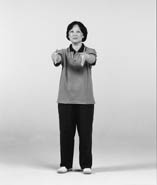 From the vast void, the infinity, the universe developed into a state of Tai Chi, the infinitive or supreme ultimate (similar to the Big Bang Theory of the modern science). Everything in the universe are comprised of two opposite and complementary halves, yin and yang. The main purpose of this is for Dan Tian awareness.
From the vast void, the infinity, the universe developed into a state of Tai Chi, the infinitive or supreme ultimate (similar to the Big Bang Theory of the modern science). Everything in the universe are comprised of two opposite and complementary halves, yin and yang. The main purpose of this is for Dan Tian awareness.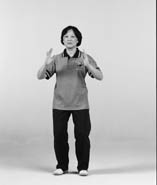 This is the working of yin and yang. Closing is yin and opening is yang. The purpose of this exercise is for breathing awareness. Breathing is the centre of all qigong exercise. The ancient Chinese believed breath is life and Qi is the life energy to maintain health and inner strength.
This is the working of yin and yang. Closing is yin and opening is yang. The purpose of this exercise is for breathing awareness. Breathing is the centre of all qigong exercise. The ancient Chinese believed breath is life and Qi is the life energy to maintain health and inner strength.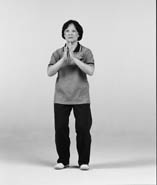
 This is for Qi awareness. It helps to circulate and cultivate your life energy.
This is for Qi awareness. It helps to circulate and cultivate your life energy.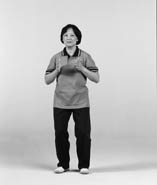 Q2A : Slowly bring your hands up, breathing in.
Q2A : Slowly bring your hands up, breathing in.